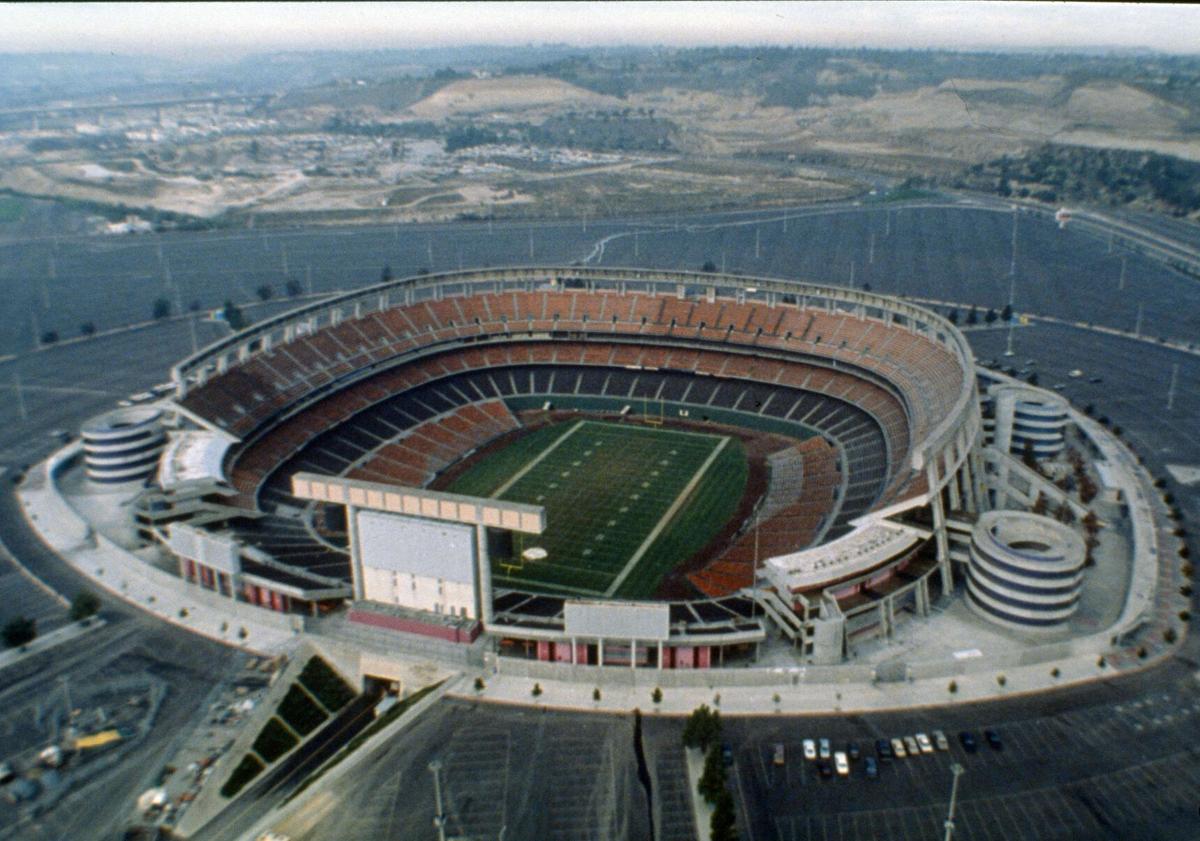
The Los Angeles Chargers History
Click play to listen to NFL music while reading.
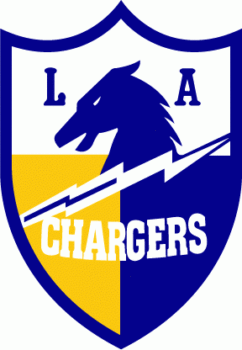
The Los Angeles Chargers football club began play in 1960 as a charter member of the American Football League (AFL), and spent its first season in Los Angeles, before moving to San Diego in 1961. The San Diego Chargers played in San Diego for 56 years. A return to Los Angeles was announced for the 2017 season, just one year after the Rams had moved back themselves. The team is now called the Los Angeles Chargers, the NFL team will play their home games at the StubHub Center until the opening of the state of the art Los Angeles Stadium at Hollywood Park in 2020, which they will share with the Rams.
The San Diego Chargers played their original games at Balboa Stadium, then in 1969, the Chargers moved into San Diego Stadium which at the time was a state of the art duel sport stadium that also hosted the San Diego Padres baseball club. The stadium was renamed in the eighties “San Diego Jack Murphy Stadium” in honor of the famous sports writer that helped get the stadium built. The stadium was renamed “Qualcomm Stadium” in the nineties, as the city sold the naming rights to help with stadium expansion funding.
The San Diego Chargers had been the only NFL team based in Southern California since the Raiders and Rams moved out of Los Angeles in 1994.
The Chargers won one AFL title in 1963 and reached the AFL playoffs five times and the AFL Championship four times before joining the NFL (1970) as part of the AFL–NFL merger. In the 43 years since then, the Chargers have made 13 trips to the playoffs and four appearances in the AFC Championship game. At the end of the 1994 season, the Chargers faced the San Francisco 49ers in Super Bowl XXIX and lost 49–26. The Chargers have seven players and one coach enshrined in the Pro Football Hall of Fame in Canton, Ohio: wide receiver Lance Alworth (1962–1970), defensive end Fred Dean (1975–1981), quarterback Dan Fouts (1973–1987), head coach/general manager Sid Gillman (1960–1969, 1971), wide receiver Charlie Joiner (1976–1986), offensive linemanRon Mix (1960–1969), tight end Kellen Winslow (1979–1987), and linebacker Junior Seau (1990–2002).
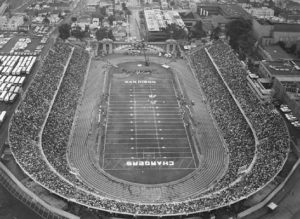
1961-1970: the AFL years
Los Angeles Chargers were established with seven other American Football League teams in 1959. In 1960, the Chargers began AFL play in Los Angeles. The Chargers’ original owner was hotel heir Barron Hilton, son of Hilton Hotels founder Conrad Hilton.
According to the official website of the Pro Football Hall of Fame, Barron Hilton agreed after his general manager, Frank Leahy, picked the Chargers name when he purchased an AFL franchise for Los Angeles: “I liked it because they were yelling ‘charge’ and sounding the bugle at Dodgers Stadium and at USC games.” The Chargers initially considered playing at the Rose Bowl, but instead signed a lease to play at the Los Angeles Coliseum. The Chargers only spent one season in Los Angeles before moving to San Diego in 1961. From 1961 to 1966 their home field was Balboa Stadium in Balboa Park. As of August 1967, they moved to the newly constructed Qualcomm Stadium (then named San Diego Stadium), where they played their home games until 2016.
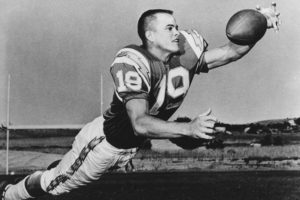
The early AFL years of the San Diego Chargers were highlighted by the outstanding play of wide receiver Lance Alworth with 543 receptions for 10,266 yards in his 11-AFL/NFL-season career. In addition he set the pro football record of consecutive games with a reception (96) during his career. During his Chargers career, Alworth set pro football records with catches in 96 straight games and seven straight 1,000-yard receiving seasons. He was the first pro receiver to have five games with 200 or more receiving yards and is the only receiver to average more than 100 yards per game in three straight seasons.
He caught 493 passes for 9,584 yards and 81 touchdowns in nine seasons for the Chargers – averaging more than 50 catches and 1,000 yards a season . . . at a clip of 19.5 yards a catch.
Their only coach for the ten-year life of the AFL was Sid Gillman, a Hall of Famer who was considered the foremost authority on the forward passing offense of his era. With players such as Lance “Bambi” Alworth, Paul Lowe, Keith Lincoln and John Hadl, the high-scoring Chargers won divisional crowns five of the league’s first six seasons and the AFL title in 1963 with a 51–10 victory over the Boston Patriots.
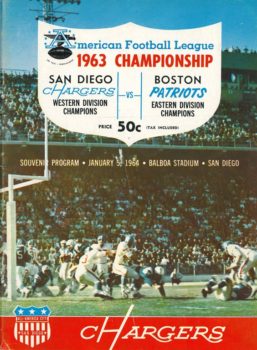
They also played defense, as indicated by their professional football record 49 pass interceptions in 1961, and featured AFL Rookie of the Year defensive end Earl Faison. The Chargers were the originators of the term “Fearsome Foursome” to describe their all-star defensive line, anchored by Faison and Ernie Ladd (the latter also excelled in professional wrestling). The phrase was later appropriated by the Los Angeles Rams. Hilton sold the Chargers to a group headed by Eugene Klein and Sam Schulman in August 1966. The following year the Chargers began “head to head” competition with the older NFL with a preseason loss to the Detroit Lions. The Chargers defeated the defending Super Bowl III champion New York Jets 34–27 before a record San Diego Stadium crowd of 54,042 on September 29, 1969. Alworth once again led the team in receptions with 64 and 1,003 yards with four touchdowns. The team also saw Gillman step down due to health and offensive backfield coach Charlie Waller promoted to head coach after the completion of the regular season. Gillman did remain with the club as the general manager.
1970–78: Post-merger
In 1970, the Chargers were placed into the AFC West division after the NFL merger with the AFL. But by then, the Chargers fell on hard times; Gillman, who had returned as general manager, stepped down in 1971, and many of the Charger players from the 1960s had already either retired or had been traded. The Chargers acquired veteran players like Deacon Jones and Johnny Unitas; however, it was at the later stages of their careers and the team struggled, placing third or fourth in the AFC West each year from 1970 to 1978. During the 1973 season, the Chargers were involved in the first major drug scandal in the NFL.
1978 was marked by the “Holy Roller” game, or as Chargers fans call it, the “Immaculate Deception”. It was a game-winning play executed by the Oakland Raiders against the Chargers on September 10, 1978, in San Diego at Jack Murphy Stadium. With 10 seconds left in the game, the Raiders had possession of the ball at the Chargers’ 14-yard line, down 20–14. Raiders quarterback Ken Stabler took the snap and found himself about to be sacked by Chargers linebacker Woodrow Lowe on the 24-yard line. Stabler fumbled the ball forward, and it rolled forward towards the San Diego goal line. Running back Pete Banaszak tried to recover the ball on the 12-yard line, but could not keep his footing, and the ball was pushed even closer to the end zone.
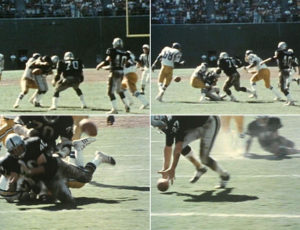
Raiders tight end Dave Casper was the next player to reach the ball but he also could not get a hand on it. He batted and kicked the ball into the end zone, where he fell on it for the game-tying touchdown as time ran out. With the ensuing extra point by kicker Errol Mann, the Raiders won 21–20. What many Charger fans believed should have been called an incomplete pass (and possibly intentional grounding) was seen as a fumble and the rest of the play involved batting of the ball forward towards the end zone where the Raiders ultimately recovered it for a touchdown. As a result of this play, NFL rules were changed so that, in the last two minutes of a half or game, or on fourth down at any time in the game, the only offensive player allowed to advance a fumble is the player who originally fumbled. If any other offensive player recovers the fumble and advances the ball, after the play the line of scrimmage is the spot of the original fumble.
1979 marked a turning point for the Chargers franchise as The Sporting News named team general manager John Sanders NFL Executive of the Year after balloting of other NFL executives. Fouts set an NFL record with his fourth consecutive 300-yard passing game, in a game in which he threw for 303 yards against the Raiders. Coached by Don Coryell (with an offense nicknamed “Air Coryell”), featuring Fouts throwing to tight end Kellen Winslow and wide receivers John Jefferson and Charlie Joiner,
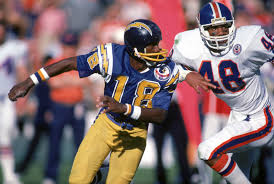
they clinched their first playoff berth in 14 years with a 35–0 victory against the New Orleans Saints. On December 17, the Chargers defeated the Denver Broncos 17–7 for their first AFC West division title since the AFL-NFL merger before a national Monday Night Football television audience and their home crowd. Their time in the playoffs was short as they would lose to the Houston Oilers 17–14 in the divisional round. Ron Mix became the second AFL player and second Charger to be named to the Pro Football Hall of Fame, during halftime of the AFC-NFC Pro Bowl.
1980
The 1980 team saw the team trade for running back Chuck Muncie,
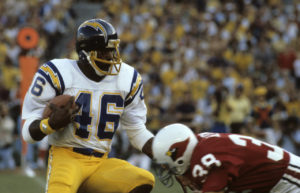
The 1980 team saw the team trade for running back Chuck Muncie, and 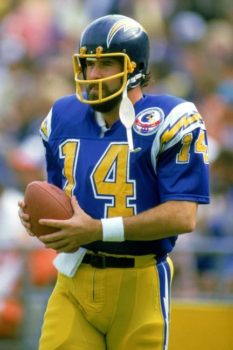 Dan Fouts set a club record with 444 yards passing in the Chargers’ 44–7 victory over the New York Giants. Kellen Winslow caught 10 passes for 171 yards and Chargers clinched their second straight AFC West title by defeating the Pittsburgh Steelers 26–17 and finished the regular season with an 11–5 record. Jefferson (1,340), Winslow (1,290), and Joiner (1,132) became the first trio on the same team to have 1,000 yards receiving in a season. The Chargers’ defense led the NFL in sacks (60) spearheaded by the frontline of 1975 Chargers’ draftees Fred Dean, Gary “Big Hands” Johnson and Louie Kelcher. The trio, along with Leroy Jones formed a defensive frontline that was locally nicknamed Bruise Brothers. In the playoffs, they won the divisional round 20–14 over the Buffalo Bills. However, they fell one game shy of Super Bowl XV in a 34–27 loss to the eventual champion Raiders.
Dan Fouts set a club record with 444 yards passing in the Chargers’ 44–7 victory over the New York Giants. Kellen Winslow caught 10 passes for 171 yards and Chargers clinched their second straight AFC West title by defeating the Pittsburgh Steelers 26–17 and finished the regular season with an 11–5 record. Jefferson (1,340), Winslow (1,290), and Joiner (1,132) became the first trio on the same team to have 1,000 yards receiving in a season. The Chargers’ defense led the NFL in sacks (60) spearheaded by the frontline of 1975 Chargers’ draftees Fred Dean, Gary “Big Hands” Johnson and Louie Kelcher. The trio, along with Leroy Jones formed a defensive frontline that was locally nicknamed Bruise Brothers. In the playoffs, they won the divisional round 20–14 over the Buffalo Bills. However, they fell one game shy of Super Bowl XV in a 34–27 loss to the eventual champion Raiders.
In 1981, the Chargers won their third straight AFC West title with a 10–6 season. After the division titles of the 1979 and 1980 seasons, contract disputes arose and owner Klein refused to renegotiate players’ contracts. They traded wide receiver John Jefferson to the Green Bay Packers after he held out for an increase in salary but replaced him with Wes Chandler. Defensive end Dean also became involved in a holdout and was traded to the 49ers. Dean contends he was making the same amount of money as his brother-in-law who was a truck driver. Dean won UPI NFC Defensive Player of the Year (while playing in only 11 games) that same year en route to a Super Bowl victory and helped the 49ers to another Super Bowl title two years later. Dean’s loss was particularly damaging to the
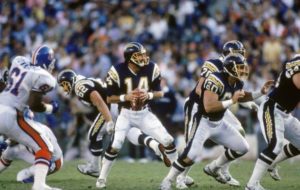
Chargers’ Super Bowl chances as the defense weakened afterwards, surrendering the most passing yards in the NFL in both 1981 and 1982.
In the 1981 playoffs, the Chargers outlasted the Miami Dolphins in the divisional round, 41–38, in a game that became known as The Epic in Miami. The game was voted as the best game in NFL history by a panel of ESPN journalists. The temperature was 85 °F with high humidity (29.4 °C) at the Miami Orange Bowl, but it did not stop either team’s offense. The Chargers were led by quarterback Dan Fouts who made the Pro Bowl for the third year in a row, setting an NFL single-season record at that time of 4,802 yards and 33 touchdowns. The Dolphins were led by head coach Don Shula and featured a defense that gave up the fifth-fewest points in the NFL in the regular season.

This game set playoff records for the most points scored in a playoff game (79), the most total yards by both teams (1,036), and most passing yards by both teams (809). Chargers placekicker Rolf Benirschke eventually kicked the winning 29-yard field goal after 13:52 of overtime to help San Diego beat Miami, 41–38.
The image of an exhausted tight end Kellen Winslow, who finished the game with 13 receptions for 166 yards and a touchdown and one blocked field goal, being helped off the field by two of his Chargers teammates has been replayed countless times. Winslow was voted to the Pro Football Hall of Fame in 1995.
However, the eventual-AFC Champion Cincinnati Bengals, playing in their first AFC Championship Game, defeated the Chargers 27–7 in what became known as the Freezer Bowl.
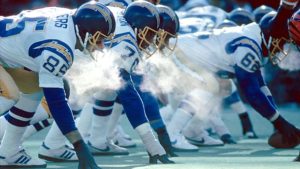
The temperature of −9° with a wind-chill factor of −59° made this the coldest weather conditions for a title game in the history of the NFL. Chargers owner Eugene Klein tried to get the NFL and Bengals to postpone the game but he was turned down.
1982–88
During the strike-shortened 1982 season, Fouts averaged what was then a record of 320 yards passing per game. (The NFL record is 342.31, set by Peyton Manning in 2013.) Highlights that season included back-to-back victories against the 1981 Super Bowl teams San Francisco (41–37) and Cincinnati (50–34) in which Fouts threw for over 400 yards in each game to lead the Chargers to shootout victories.
The Chargers made it back to the playoffs, but after beating the Steelers in the first round, they lost to the Dolphins 34–13 in a rematch of their playoff game from the previous season. That loss began a slide for the Chargers, who from 1983 to 1991 failed to make the playoffs every season.
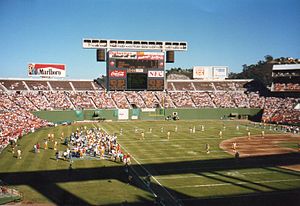
In 1984, Klein cut salary in preparation of selling the team, sending defensive linemen Johnson and Kelcher to San Francisco, where they would join Dean and offensive tackle Billy Shields for another 49ers championship in Super Bowl XIX. Alex Spanos purchased a majority interest in San Diego from Klein on August 1. Alex G. Spanos still owns 97% of the team and George Pernicano owns the other 3%. Benirschke was named “Miller Man of the Year” and Joiner set an NFL record with his 650th pass reception in the fourth quarter of the game at Pittsburgh. In 1985 guard Ed White set an NFL record by playing in 241 NFL games, most all-time among offensive linemen. Lionel “Little Train” James, a mere 5’6″ and 171 pound running back, set NFL record of 2,535 all-purpose yards while also setting a record of 1,027 receiving yards by a running back. Al Saunders was named the seventh head coach in Chargers history in 1986 following the resignation of Coryell. In 1987 Joiner retired to become receivers coach of the Chargers. The Chargers finished with an 8–7 record, their first winning record since 1982, despite winding up with six straight losses. In 1988 Fouts retired after a 15-year career in which he set seven NFL records and 42 club records, and became the NFL’s second most prolific passer of all-time with 43,040 yards. Fouts’s jersey number (14) was retired at halftime of “Dan Fouts Day” game in San Diego.
1989–1994: Super Bowl bound
In 1989, Dan Henning, a former Chargers quarterback, Washington Redskins assistant, and Atlanta Falcons head coach, was named the eighth head coach in Chargers history. First-year running back Marion Butts set a club record with 39 carries and a team rookie record with 176 yards in Chargers’ 20–13 win in Kansas City. After a three-year stint as Director of Football Operations, Steve Ortmayer was released after the season and replaced by Bobby Beathard.
Following Henning’s three-season stint with the Chargers, Bobby Ross was hired as the ninth head coach in 1992. Additionally, the Chargers acquired quarterback
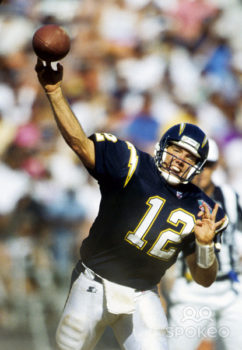
Stan Humphries in a trade with the Washington Redskins. The Chargers would lose their first four games of the season and come back to become the first 0–4 team to make the playoffs as they won 11 of the last 12 games and clinched the AFC West title. Ross was named NFL Coach of the Year for the Chargers’ dramatic turnaround by Pro Football Weekly. In the first round of the playoffs, the Chargers shut out the Chiefs 17–0, but the Dolphins shut out the Chargers in the divisional playoffs to eliminate the Chargers. In 1993, the Chargers finished 8–8 (fourth in their division).
In the 1994 season, the Chargers made their first and, so far, only Super Bowl appearance, against the 49ers in Super Bowl XXIX. They got to the Super Bowl by winning their first six regular season games, the only NFL team to do so in 1994, and finished the season 11–5. Quarterback Stan Humphries and wide receiver Tony Martin combined on a 99-yard touchdown completion to tie an NFL record during a defeat of the Seattle Seahawks, 27–10. They would become the 1994 AFC West Division champions behind a defense led by linebacker Junior Seau,
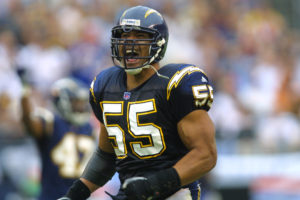
defensive tackles Reuben Davis and Shawn Lee, defensive end Leslie O’Neal and an offense keyed by running back Natrone Means,
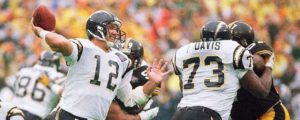
Humphries and Martin. The Chargers had upset victories over the Dolphins and Steelers in the AFC playoffs. Despite those two close triumphs (22–21 against the Dolphins in the Divisional Round, and 17–13 against the Steelers in the AFC Championship Game), the Chargers lost Super Bowl XXIX to the San Francisco 49ers by a score of 49–26, who were led by quarterback Steve Young (Super Bowl MVP) and wide receiver Jerry Rice.
Despite the lopsided loss in the Super Bowl, Beathard, who traded for or drafted the bulk of the Chargers roster, and who hired coach Ross, was named the NFL’s smartest man by Sports Illustrated, and became the only general manager to lead three different teams to the Super Bowl (Chargers, Dolphins, Redskins).
1995–2004
The Chargers’ follow-up year in 1995 did not bring the same success of the previous season, but the team still managed to get into the playoffs with a five-game winning streak to end the season at 9–7. However, in the first round, the Chargers were eliminated by the Indianapolis Colts in a 35–20 defeat.
In 1996, running back Rodney Culver and his wife, Karen, were killed in the crash of ValuJet Flight 592 in the Florida Everglades. Culver was the second player in team history to die while on the active roster after David Griggs was killed in a one-car accident in Davie, Florida, 11 months earlier. In 1997, Ross and Beathard were at odds with one another, resulting in Ross and his staff being released. The Chargers selected Kevin Gilbride to become their new head coach. Gilbride, whose coaching background with the Jacksonville Jaguars and Oilers featured a more open passing attack, would mark a major change in offensive style from the ball control ground game of Ross. Beathard drafted quarterback Ryan Leaf after the Indianapolis Colts selected Peyton Manning with the first pick in the 1998 NFL Draft. The Chargers traded several players and draft choices to the Arizona Cardinals in order to move up to the second pick and select Leaf. Leaf turned out to be arguably the biggest bust in NFL history. His poor play and attitude caused his departure after the 2000 season. In 1998, the Chargers went 5–11. Said safety Rodney Harrison, “If I had to go through another year like that, I’d probably quit playing.”

The Chargers struggled in pass protection, resulting in Humphries suffering several concussions and his retirement from the game. Gilbride was replaced by interim head coach June Jones, who was on the Chargers’ staff before the hire. Jones left the team at the end of the season to coach at the University of Hawaii and the Chargers named former Oregon State University head coach Mike Riley as their new head coach. Leaf wound up having a disappointing career with the Chargers after a great deal of controversy with both the Charger management as well as the press and his teammates. His failure to be the player the team envisioned was seen as a black mark on the franchise and is generally considered one of the worst draft/trades in the history of pro football. Quarterback Jim Harbaugh, who was acquired in a trade with the Baltimore Ravens for a conditional draft choice in 2000, became the Chargers starting quarterback. Beathard retired in April 2000 and was replaced in January 2001 by John Butler, former general manager of the Bills. From 1996 to 2003, the Chargers had eight-straight seasons where they were .500 or worse.
In 2001, Norv Turner, the former head coach of the Redskins, was named offensive coordinator by Riley. Turner installed the offense that he coached with the Dallas Cowboys under Jimmy Johnson. Turner learned the offense from Ernie Zampese, former offensive coordinator during the Coryell era,
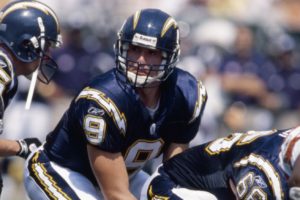
while the two were on the Los Angeles Rams coaching staff. The Chargers signed Heisman Trophy winner free agent quarterback Doug Flutie, formerly with the Bills, and traded the team’s first overall selection in the 2001 NFL Draft to the Atlanta Falcons for the first-round selection (5th overall) and third-round selection in the same draft. In addition the Chargers obtained wide receiver-kick returner Tim Dwight and the Falcons’ second-round draft selection in the 2002 NFL Draft. The Chargers used those selections in the 2001 draft to select Texas Christian University running back LaDainian Tomlinson and Purdue University quarterback Drew Brees.
Hired as a replacement to Riley, Marty Schottenheimer’s
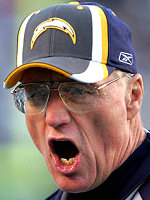
Chargers squad opened the 2002 season with four-straight victories, making him the only coach in team history to win his first four games. Butler would succumb to cancer after a nine-month struggle in April 2003. Replacing Butler was A. J. Smith, who was named Executive Vice President-General Manager, replacing his close friend. Smith and Butler had worked together with the Bills, playing key roles with Buffalo’s Super Bowl teams. In 2003, the Chargers traded Seau to the Dolphins for a draft pick in 2004 NFL Draft. Seau was selected to 2003 Pro Bowl, his 12th Pro Bowl selection of his career, and in his final season with the Chargers, he was chosen by teammates as the recipient of the Emil Karas Award as the team’s Most Inspirational Player. Also in 2003, Tomlinson accumulated 195 total yards from scrimmage in a late-season game against the Packers to raise his season total to 2,011 and became the first player in team history and the eighth player in NFL history to record consecutive 2,000-yard seasons. Tomlinson also became the first player in NFL history to rush for 1,000 yards and catch 100 passes in the same season.
The Chargers coveted Eli Manning and wanted to select him with their first round pick, which was also the first overall pick of the draft. However, after Eli Manning indicated before the draft that he would not sign with the San Diego Chargers, they were forced to adjust their plans. Philip Rivers was their first alternative to Manning because the Chargers head coach at the time, Marty Schottenheimer, had coached Rivers at the Senior Bowl and he liked what he saw from Rivers. The Chargers agreed to a trade on draft day with the New York Giants. Manning was selected by the San Diego Chargers then later in the draft traded for Rivers, selected with the fourth pick by the Giants. The Chargers also received draft picks from the Giants that were used to select future Pro Bowlers Shawne Merriman and Nate Kaeding. Rivers was one of seventeen quarterbacks taken in the 2004 NFL Draft along with Ben Roethlisberger, Eli Manning, and Matt Schaub. Rivers, Roethlisberger, Schaub and Manning have been voted to the Pro Bowl since becoming starters, none had produced a season with a losing record until Schaub in in 2010, but Roethlisberger and Manning both have won two Super Bowls. They have been compared favorably to the Quarterback class of 1983, which included Hall of Fame quarterbacks John Elway (1st pick), Jim Kelly (14th), and Dan Marino (27th).
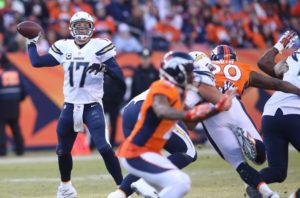
In August 2004, Rivers signed a six-year, $40.5 million contract that included $14.5 million in signing bonuses. However, due to a protracted contract negotiation, Rivers only reported to the team during the last week of training camp, and incumbent Drew Brees retained his starting job. After the starting quarterback switch, it was almost certain Brees’ days as the Chargers’ starting QB were over. However, Rivers held out nearly all of training camp, and Brees remained the starter throughout the 2004 season, where he started 15 games and led the team to a 12-4 regular season record. Brees posted spectacular numbers, completing 65.5% of his passes for 3,159 yards, with 27 touchdowns to only 7 interceptions, giving him a 104.8 passer rating. The Chargers won the AFC West and Brees was selected to the 2004 Pro Bowl. He was named 2004 NFL Comeback Player of the Year.
Marty Schottenheimer was named NFL Coach of the Year for the 2004 NFL season. He led the team to a playoff appearance, his 12th as a head coach. However, it resulted in a disappointing loss to the underdog New York Jets in overtime in 2005.

During the 2005 NFL Draft, the Chargers tried to get some key rookies that would help carry the momentum from their mostly successful 2004–05 run. They used their first pick on LB Shawne “Lights Out” Merriman from the University of Maryland. Merriman was among the top linebackers in the NFL in his first three seasons with the San Diego Chargers, where he was a three-time Pro Bowl and All-Pro selection. Merriman was drafted 12th overall by the San Diego Chargers in the 2005 NFL Draft. He earned NFL Defensive Rookie of the Year honors in his first season and recorded 39 1⁄2 quarterback sacks in his first three seasons. He was hampered by injuries his next three seasons, and the Chargers waived Merriman midseason in 2010. He was acquired through waivers by the Buffalo Bills that season, but he only played minimally with the Bills due to continued injuries. He was released by the Bills before the 2012 season before they re-signed him mid-season.
The Chargers used their next 2005 draft pick on DT Luis Castillo from Northwestern University. Their other choices were WR Vincent Jackson from Northern Colorado,
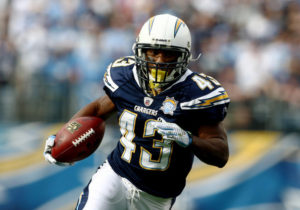
RB Darren Sproles from Kansas State, OT Wesley Britt from University of Alabama, OT Wes Sims from Oklahoma University, and Center Scott Mruczkowski from Bowling Green State.
The Chargers got off to a rough start in their 2005 campaign, losing a close one to the Dallas Cowboys in their Week 1 home-opener (28–24) and then they lost on the road to their AFC West rival, the Denver Broncos (20–17). It wasn’t until a Week 3 home game on Sunday night that they got their first win of the season, when Eli Manning and the New York Giants got “shocked to the system” as LaDainian Tomlinson had one of the greatest games of his career. He got 220 total yards, had 3 rushing touchdowns, and threw for a touchdown as he helped the Chargers win 45–23.
A week later, they were able to build off their win by not only beating the two-time defending champion New England Patriots 41–17, but also ending the Pats’ 21-game winning streak at home. In their Week 5 Monday Night home game against the Pittsburgh Steelers, the Chargers wore their throw-back uniforms during this season (they had also worn them during the 1994 season). The Steelers held on to win with a 40-yard field goal by Jeff Reed (24–22). The Chargers rebounded on the road against their division rival Oakland Raiders (27–14). In their Week 7 road trip to Philadelphia, they hoped to build off their win against the Eagles. Late in the game, with the Chargers leading 17–13, the Chargers tried to go for a field goal to put their lead well out of reach, but it got blocked and Eagles DB Matt Ware returned it 65 yards for the game-winning touchdown and the Chargers fourth loss of the season.
After going 3–4, the Chargers turned things around as they began a five-game winning streak. They won at home against division-rival Kansas City Chiefs (28–20) and on the road against the New York Jets (31–26). Coming off their Week 10 bye, they went home and wore their throw-back uniforms again. This time, it was a dominating performance as the Chargers man-handled the Buffalo Bills, 48–10. Then, they went on the road and won a close match against the Washington Redskins (23–17 in OT) and then they swept the Oakland Raiders at home by a score of 34–10.
The Chargers were 8–5, coming off a 23–21 loss to the Miami Dolphins. On December 18, the Chargers beat the undefeated Indianapolis Colts 26–17, snapping a 13–0 winning streak. However, despite a record of 9–6, they were officially eliminated from AFC playoff contention in 2005 after a 20–7 loss to the Kansas City Chiefs the following Saturday. The Chargers lost their final game of the season by a score of 23–7 to the AFC West champion Denver Broncos to finish with a record of 9–7.
2006–2009
The Chargers delivered an impressive performance in 2006, losing only to the Ravens and Chiefs, they finished 14–2 which secured them the #1 AFC seed in the playoffs. However, they lost 24-21 to the New England Patriots in the divisional round.
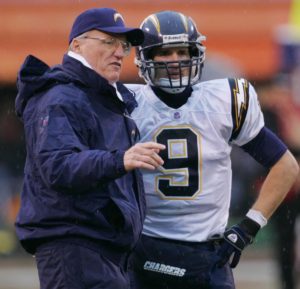
Chargers coach Marty Schottenheimer was fired on January 7 2007 in a shocking move by team president Dean Spanos, who cited a “dysfunctional situation” between the head coach and general manager A.J. Smith. The move was first reported by ESPN’s Chris Mortensen. Less than a month after San Diego’s NFL-best 14-2 season was wrecked in a playoff loss to New England, Spanos cited the exodus of both coordinators and other assistants in firing Schottenheimer,
who had a year left on his contract.
“This decision was so hard because Marty has been both a friend and valued coach of our team,” Spanos said in a statement. “But my first obligation is always to do what is in the best interest of our fans and the entire Charger organization. I must take whatever steps are necessary to deliver a Super Bowl trophy to San Diego. Events of the last month have now convinced me that it is not possible for our organization to function at a championship level under the current structure. On the contrary, and in the plainest possible language, we have a dysfunctional situation here. Today I am resolving that situation once and for all.
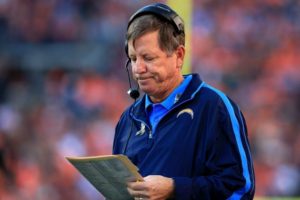
Under new head coach Norv Turner in 2007, the Chargers were 11-5, beating the Tennessee Titans and the defending champion Indianapolis Colts to reach the AFC title game. However, they fell to the Patriots for the second year in a row. In 2008, the Chargers dropped to 8–8, but as the AFC West was unusually weak that year, they still managed to win the division title. Defeating the Colts in the wild card round, they lost to the Pittsburgh Steelers in the divisional round.
San Diego began the 2009 2–3. After losing to the Broncos on Monday night, they began an unbroken winning streak for the rest of the season, which included defeating the entire NFC East. In Week 11, they avenged their earlier loss against the Broncos by inflicting a 32–3 rout on them. The next game saw them beat a 1–11 Cleveland Browns squad 30-23, in which LaDainian Tomlinson broke Hall of Famer Jim Brown’s rushing record and was congratulated by him afterwards. The Chargers secured another division title, the #2 AFC seed, and looked to be a near shoo-in for the Super Bowl. However, the team’s postseason futility continued. Hosting the New York Jets on January 17, 2010, they endured an upset defeat, where, despite an early lead, were unable to overcome the strong Jets’ defense. Kicker Nate Kaeding also missed three field goal and PAT attempts, which resulted in the Chargers losing 17–14.
2010–2012: End of the Norv Turner/A.J. Smith era
The 2010 season was the 1st season without LaDainian Tomlinson since 2000 (Tomlinson was let go by management due to an oversized contract relative to production and other issues; he went on to lead the Jets in rushing with 914 yards & tied for 3rd in receptions with 52). The 2010 campaign started off slowly again, this time 2–5 (including losses to some of the worst teams in football at the time – the Kansas City Chiefs, the Oakland Raiders, the Seattle Seahawks and the St. Louis Rams). The losses were due to turnovers & mental mistakes by young players on special teams allowing blocked punts & kick/punt return touchdowns. The loss to Oakland ended their 13-game winning streak against the Raiders since their last loss on September 28, 2003. The Chargers then went on another second half run with four straight wins but this time instead of keeping the streak going the entire second half they had a big let down losing at home to the Raiders again, this time 28–13 (ending their shared NFL record, with the Dolphins, of 18 straight wins in December). Despite the loss, they still had a chance to win their 5th straight AFC West title, tying the Raiders, but they had another bad loss at the Bengals 34–20 ending their chances. The Chargers beat Denver to end the season with a 9–7 record & out of the playoffs for the first time since 2005. They finished the season as the 8th team in NFL history to rank #1 in overall offense (395.6 yards/game), and overall defense (271.6 yards/game), and became only the 2nd of those teams to not make the playoffs (1953 Eagles 7–4–1). They were second to the Colts in passing yards per game (282.4), second to the Patriots in points scored per game (27.6), 1st in passing yards allowed per game (177.8), 4th in rushing yards allowed per game (93.8), and tied for 2nd in sacks (47). On the negative stat sheet, they gave up the most punt return yards per game (18.9) & had 29 turnovers. Philip Rivers had another great season with a career-high 4,710 yards (#1 in the NFL), 294 yards passing per game (tied for 1st with Manning), 66% completion pct. (third to Brees & Manning), 30 TD’s, only 13 INT’s & a 101.8 passer rating (second to Brady). Mike Tolbert 11 rushing TD’s & Antonio Gates 10 receiving TD’s were among the league leaders in TD’s scored. On defense, Shaun Phillips’ 11 sacks were in the top 10.
With the special teams failure of the 2010 season campaign, the Chargers hoped to rebound with a strong performance to start the season, and a way to overcome slow starts.
The Chargers started off the 2011 season with a 4–1 campaign, with their only loss to the New England Patriots. From that point on, however, the Chargers began a six-game skid with losses to the Jets, Chiefs, Packers, Raiders, Bears, and Broncos, with the first four by only a score and against Denver in overtime. Injuries to both the offensive and the defensive line hit the Chargers hard. But finally on December 5, 2011, the Chargers got their first win in over a month against the Jacksonville Jaguars, beating the also-struggling team. The Chargers then began a three-game winning streak most notably beating the Ravens by more than any team has beat them that season. However, the Chargers were beaten, 38–10, by the Detroit Lions to drop their record to 7–8 and eliminate the possibility of being in the playoffs. After a 38–26 victory over the Raiders in week 17, the Chargers finished at 8–8 and in a numerical tie for first place in the AFC West along with Oakland and Denver. However, the Chargers were beaten out by Denver for the Division Title via tie-breaker. After missing the playoffs for the third straight season in 2012, the Chargers fired general manager Smith and head coach Turner.
2013–2016: Mike McCoy era and final years in San Diego
The Chargers made offseason changes including a new General Manager, Tom Telesco, and head coach, Mike McCoy, the former offensive coordinator for the Denver Broncos. On January 9, 2013, the Chargers announced that Tom Telesco, former Vice President of Football Operations with the Indianapolis Colts, would take over as General Manager following the firing of A. J. Smith. On January 15, 2013, Broncos offensive coordinator, Mike McCoy, was hired as the new head coach and Ken Whisenhunt as offensive coordinator. The San Diego Chargers selected D. J. Fluker, Manti Te’o, and Keenan Allen in the first three rounds of the 2013 NFL Draft.
The Chargers finished the 2013 season 9-7 and made the playoffs for the first time since 2009. They entered the playoffs as the sixth seed. On January 5, 2014, the Chargers defeated the Cincinnati Bengals at Paul Brown Stadium (27-10) to advance to the AFC Divisional Playoff Round. The Chargers then lost to the Denver Broncos at Sports Authority Field at Mile High the following Sunday, January 12, 2014 (24-17).
The San Diego Chargers selected Jason Verrett, Jeremiah Attaochu, and Chris Watt in the first three rounds of the 2014 NFL Draft.
After starting the season strongly, including a five-win run in September and October, the Chargers were beset by a string of injuries to key players, and eventually finished the season at 9-7. In contrast to 2013, the record was not enough to make the playoffs. The Chargers began the season 5–1, winning five straight after losing their season opener. It was followed by a three-game losing streak, and they finished 4–4 in the second half. They won just two of their final five games, coming back from double-digit fourth quarter deficits twice to remain in playoff contention. They lost the final game of the season when a win would have secured a playoff berth. In three of their last four games, and five of their last eight, the Chargers did not score more than one touchdown. Compared to 2013, the offense dropped in points (from 12th in the league to 17th), yards (5th to 18th), first downs (3rd to 15th), net yards per pass (2nd to 8th), rushing yards (13th to 30) and yards per rush (21st to 31st). It was the second time in three years the team finished second-to-last in yards per carry. San Diego was just 2–4 against teams in their division in the AFC West, and were swept by both the Denver Broncos and the Kansas City Chiefs. It was their worst intradivision record since they were 1–5 in 2003. The Chargers were only 3–6 against teams with winning records. They matched their 9–7 record from 2013, but missed the playoffs for the fourth time in five seasons.
During the season, the Chargers, the St. Louis Rams, and the Oakland Raiders all intimated they might apply for relocation to Los Angeles at the end of the season. The Chargers announced in December 2014 that they would not be seeking to relocate for the 2015 season, followed by an announcement from the NFL that no team would relocate to L.A. until the 2016 season at the earliest.
Controversy filled the 2015 offseason, as attorney and team spokesperson Mark Fabiani continually bashed the local San Diego city government’s efforts to negotiate a replacement for Qualcomm Stadium. When then-St. Louis Rams owner Stan Kroenke announced in January 2015 his intention to build a new stadium in Inglewood, California, the Chargers felt pressured to announce their own Los Angeles plan to preserve what they claimed was “25 percent of their fan base” in the affluent Los Angeles and Orange County areas. In February 2015, the team announced a stadium proposal in Carson, California, in partnership with the Oakland Raiders, their AFC West divisional rivals.
In the 2015 NFL draft, the Chargers selected Melvin Gordon, Denzel Perryman, and Craig Mager in the first three rounds. The season started off with a win against the Detroit Lions at home. The Chargers lost to the Cincinnati Bengals and Minnesota Vikings on the road before defeating the Cleveland Browns on a last second field goal. Following their 2–2 start, the Chargers lost their next six games, dropping to 2–8. In their six straight losses, they lost heart breakers to the Pittsburgh Steelers, Green Bay Packers, Baltimore Ravens and the Chicago Bears, as well as sound defeats by both, division rivals, the Oakland Raiders and the Kansas City Chiefs. They finally broke their losing streak by defeating the Jacksonville Jaguars on the road, bringing their record to 3–8, in last place in the AFC West and 3rd worst in the American Football Conference (one game ahead of both the Browns and the Tennessee Titans). They are also tied for the third worst record in the National Football League. They then proceeded to beat the Miami Dolphins in Week 14 winning 30–14. They finished the season 4–12.
The day following the conclusion of the 2015 regular season, the Chargers, Rams, and Raiders all filed to relocate to Los Angeles. On January 12, 2016, the NFL owners voted 30–2 to allow the Rams to return to Los Angeles and approved the Inglewood stadium project over the Carson project. The Chargers were given a one-year approval to relocate, conditioned on negotiating a lease agreement with the Rams or an agreement to partner with the Rams on the new stadium construction.
On January 14, 2016, the team filed paperwork for official trademark protection of the term “Los Angeles Chargers” for the purposes of running and marketing a professional football franchise. Later in January, the Chargers submitted to the City of Santa Ana grading and landscape plans for a five-acre parcel of land in the city that could be used as the location of interim headquarters and training facilities “in the event the team exercises its option to relocate to the Los Angeles area.” After two weeks of negotiation, the Chargers and Rams came to an agreement in principle on sharing the planned Los Angeles Stadium at Hollywood Park on January 29, 2016. The Chargers would contribute a $200 million stadium loan from the NFL and personal seat license fees to the construction costs and would pay $1 per year in rent to the Rams.
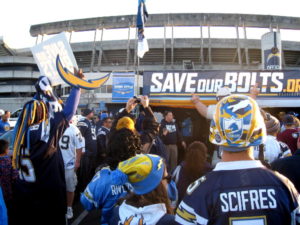
As an incentive to work out a stadium deal in their current market, the NFL pledged $100 million to the Chargers if they come to an agreement with the city of San Diego. While the team had until March 2016 to decide if they would relocate to Los Angeles for the 2016 season, Chargers chairman/CEO Dean Spanos announced on January 29, 2016, that the team would remain in San Diego for the season. The announcement stated that the team would also be working over the year with government and business leaders on a new stadium proposal that could keep the team in San Diego long-term.
The Chargers had continued preliminary work on a ballot initiative for public approval on a new facility. On February 23, 2016, the Chargers announced that their stadium efforts would be focused on a stadium in East Village, Downtown San Diego. On March 30, 2016, it was reported in the media that the details of the downtown stadium proposal were unveiled the stadium would be financed from $650 million from the team and the NFL, with a tax hike of $1.15 billion in bonds including $350 million city contribution, $600 million for the convention center, and $200 million to acquire land. On April 21, 2016, rendering of the proposed downtown stadium were unveiled by the Chargers and on April 23, 2016, the downtown stadium initiative signature collecting was launched with Roger Goodell, Philip Rivers, LaDainian Tomlinson, Mike McCoy, and Dean Spanos. On June 10, 2016, the Chargers announced that they had collected 110,786 signatures for the downtown stadium initiative 1 month later on July 9, 2016, San Diego City Clerk Liz Malland announced that the downtown Chargers stadium initiative had secured enough valid signatures to be put on the November 2016 ballot. On July 18, 2016, the San Diego City Council voted 8–0 to put the Chargers stadium plan and the Citizens Plan on the November ballot. On July 28, 2016, the San Diego Regional Chamber of Commerce announced its support of the Chargers downtown stadium proposal. On October 3, 2016, Mayor Kevin Faulconer officially announced his support of the Chargers stadium plan. On November 8, 2016, Measure C was voted down (57% opposed over 43% in support). On December 14, 2016, at an owners’ meeting, the terms of the Chargers and Rams lease agreement, as well as the team’s debt ceiling were approved thus taking the first steps for a possible relocation to Los Angeles in 2017. On December 23, 2016, the Chargers agreed to lease part of a Costa Mesa office campus for offices, practice fields, and training facility on nearly 3.2 acres.
2017–present: Relocation to Los Angeles
Spanos announced the relocation in a letter to Chargers fans posted to the team’s official site on January 12, 2017. Revealing a new marketing logo with the announcement, the team will play as the Los Angeles Chargers starting in the 2017 season at StubHub Center in Carson, California, despite the fact that the stadium seats well below the 50,000 minimum that the NFL set even for temporary homes following the 1970 merger. There had been speculation that the team may rebrand itself similar to how the Houston Oilers ultimately became the Tennessee Titans in 1999. Unlike the situation between the Cleveland Browns and Baltimore Ravens, the Oilers’ rebranding was done by the team’s choice and not by court order. The Chargers, however, announced they had no immediate plans to rebrand after the relocation. On January 13, the Chargers fired defensive coordinator John Pagano.
Logo and uniforms
Except for color changes, the Chargers have basically used the logo of an arc-shaped lightning bolt since the team debuted in 1960. During its period in the AFL, the club also used a shield logo that featured a horsehead, a lightning bolt, and the word “Chargers”.
From 1960 to 1973, the colors consisted of various shades of Electric blue (“powder” blue, but technically called Collegiate blue) or white jerseys, both with gold lightning bolts on the shoulders. The helmets were white and had both the arc-shaped lightning bolt logo, in gold or navy depending on the year, and the player’s number. At first, the team wore white pants before switching to gold in 1966.
In 1974, the sky blue was changed to dark royal blue. The helmet was also changed to dark blue and the players’ numbers were removed. Additionally, the face masks became yellow, thus making them one of the first teams in the NFL (with the Kansas City Chiefs) to use a facemask color other than the then-predominant grey. From 1978 through 1983, the Chargers wore their white jerseys at home, coinciding with the hiring of coach Don Coryell – when Joe Gibbs, a Coryell assistant in 1979–80, became head coach of the Washington Redskins in 1981, he did the same, and white at home became a Redskins staple through 2007 – but Coryell switched the Chargers to their blue jerseys at home starting in 1984. With the exception of the 1991 season and other sporadic home games since, San Diego wears its blue jerseys at home.
In 1985, the Chargers started using navy blue jerseys and returned to wearing white pants. The team’s uniform design was next revamped in 1988. It featured an even darker shade of navy blue. The lightning bolts on the jerseys and helmets were white, with navy interior trim and gold outlining. In 1990, the team started to wear navy pants with their white jerseys. From 1988 to 1991, the team displayed stripes down the pants rather than lightning bolts. The Chargers went with all-white combinations in 1997 and 2001, only to have the blue pants make a comeback. On October 27, 2003, the Chargers wore their navy pants with their navy jersey for a Monday Night Football game versus the Miami Dolphins that was played at Sun Devil Stadium, then the home of the Arizona Cardinals, due to wildfires in southern California. This remains the only game in which the Chargers have worn the all-dark combination.
From the late 1980s to 2000, the Chargers wore white at home during some preseason games and dark for regular season games. In 2001, the Chargers started wearing their dark uniforms for preseason games and white uniforms in September home games due to the heat before switching back to dark in October.
In March 2007, the Chargers unveiled their first uniform redesign since 1988, on the team’s official website. The team formally unveiled this new uniform set, which mixes old and new styles, in a private team-only event. Navy blue remains the primary color on the home jersey, but the familiar lightning bolt was reverted to gold, and now has navy outlining and powder blue interior trim. The latter color is a nod to the 1960s uniforms. The redesigned lightning bolt was moved to the sides of the shoulders from the top, and includes a new numbering font and word mark in white, with gold outlining and powder blue interior trim. The pants also have a redesigned lightning bolt in gold, with powder blue trim on a navy stripe. Additionally, the team pays tribute to other uniform features from their history by wearing a metallic white helmet, with a navy face mask, the newly revamped bolt in gold with navy and powder blue trim, and white pants. The road white jerseys with navy pants, as well as the alternate powder blue jerseys with white pants, were also redesigned with the new scheme.
From 2002 to 2006, the Chargers used the early-1960s powder blue uniforms as alternate jerseys, which many football fans (both of the Chargers and of other teams) clamored for the team to bring back full-time.
Since 2007, the Chargers have worn the alternate powder blue jerseys twice per season. The alternate powder blue jerseys have also been worn in a playoff game against the Indianapolis Colts (2008 playoffs).
In 2009, in honor of their 50th anniversary as one of the eight original AFL teams, the Chargers wore their 1963 throwback uniforms for three games.
For the 2013 season, the Chargers made minor tweaks to their current uniforms. These include a two-tone nameplate (gold with powder blue trim on home jersey, navy with gold trim on away jersey, and white with navy trim on alternate jersey), collars matching the color of the jersey, and the addition of a gold stripe on the socks.
The Chargers wear their white jerseys for home games early in the regular season due to higher summer temperatures.
Chronologigal Timeline of the Los Angeles Chargers:
1959
The Chargers currently have four retired numbers: #14 (Dan Fouts), #19 (Lance Alworth), #21 (LaDainian Tomlinson) and #55 (Junior Seau). As of 2010, the Chargers’ policy was to have the Chargers Hall of Fame committee evaluate candidates for a player’s number to retire after the player has retired from the league after five years, Seau was the only exception to this policy. The committee consists of Chargers Executive Vice President Alex Spanos, Chargers public relations director Bill Johnston, San Diego Hall of Champions founder Bob Breitbard, and the presidents of the San Diego Sports Commission and the Chargers Backers Fan Club. There are few recognized guidelines in sports regarding retiring numbers, and the NFL has no specific league policy. “You have to have enough numbers for players to wear”, said NFL spokesman Greg Aiello. The Chargers have rarely retired numbers. The San Diego Union-Tribune wrote, “The [Chargers] tend to honor their heritage haphazardly.
| Los Angeles Chargers retired numbers | |||
| No. | Player | Position | Tenure |
|---|---|---|---|
| 14 | Dan Fouts | QB | 1973–1987 |
| 19 | Lance Alworth | WR | 1962–1970 |
| 21 | LaDainian Tomlinson | RB | 2001–2009 |
| 55 | Junior Seau | LB | 1990–2002 |
Pro Football Hall of Famers
| Los Angeles Chargers Hall of Famers | ||||
| No. | Player | Position | Tenure | Inducted |
|---|---|---|---|---|
| 19 | Lance Alworth | WR | 1962–1970 | 1978 |
| 74 | Ron Mix | OT | 1960–1969 | 1979 |
| 19 | Johnny Unitas | QB | 1973 | 1979 |
| 75 | Deacon Jones | DE | 1972–1973 | 1980 |
| — | Sid Gillman | Head coach | 1960–1971 | 1983 |
| 89 | John Mackey | TE | 1972 | 1992 |
| 14 | Dan Fouts | QB | 1973–1987 | 1993 |
| 72 | Larry Little | OG | 1967–1968 | 1993 |
| 80 | Kellen Winslow | TE | 1979–1987 | 1995 |
| 18 | Charlie Joiner | WR | 1976–1986 | 1996 |
| 71 | Fred Dean | DE | 1975–1981 | 2008 |
| 55 | Junior Seau | LB | 1990–2002 | 2015 |
Chargers Hall of Fame
The Chargers created their Hall of Fame in 1976. The members of the Hall of Fame are honored at the Chargers Ring of Honor, founded in 2000 and viewable above the visiting team’s sideline of Qualcomm Stadium on the press level. Eligible candidates must have been retired for at least four seasons. Selections are made by a five-member committee chaired by Dean Spanos, Chargers vice-chairman. As of 1992, other committee members included Bob Breitbard, founder of the San Diego Hall of Champions; Ron Fowler, president of the Greater San Diego Sports Association; Jane Rappoport, president of the Charger Backers; and Bill Johnston, the team’s director of public relations. The Chargers in 2012 allowed fans to vote for the newest member.
50th Anniversary Team
The Chargers announced their 50th Anniversary Team in 2009 to honor the top players and coaches in the team’s history. The Chargers were founded in 1959. The team included 53 players and coaches selected from 103 nominees. The Chargers originally stated that only 50 members would be selected. Online voting by fans accounted for 50% of the voting results; votes from Chargers Hall of Famers and five members of the local media made up for the other 50%. Over 400,000 votes were cast online. Dan Fouts and LaDainian Tomlinson received the first and second most votes, respectively. The team features 7 Pro Football Hall of Fame members and 11 players that were active on the 2009 Chargers team.
San Diego Hall of Champions
Alworth, Mix, Hadl, Joiner, Coryell, Gillman, Garrison, Fouts, White, Winslow, Faison, Benirschke, Lincoln, Washington, Humphries, Ladd and Wilkerson are also members of the San Diego Hall of Champions, which is open to athletes from the San Diego area as well as those who played for San Diego-based professional and collegiate teams.
Current Los Angeles Chargers staff
|
|
|||||
|
||||||
San Diego Super Chargers Theme Song
Widget not in any sidebars
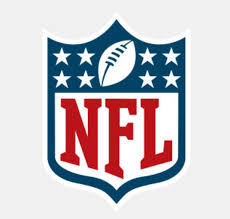
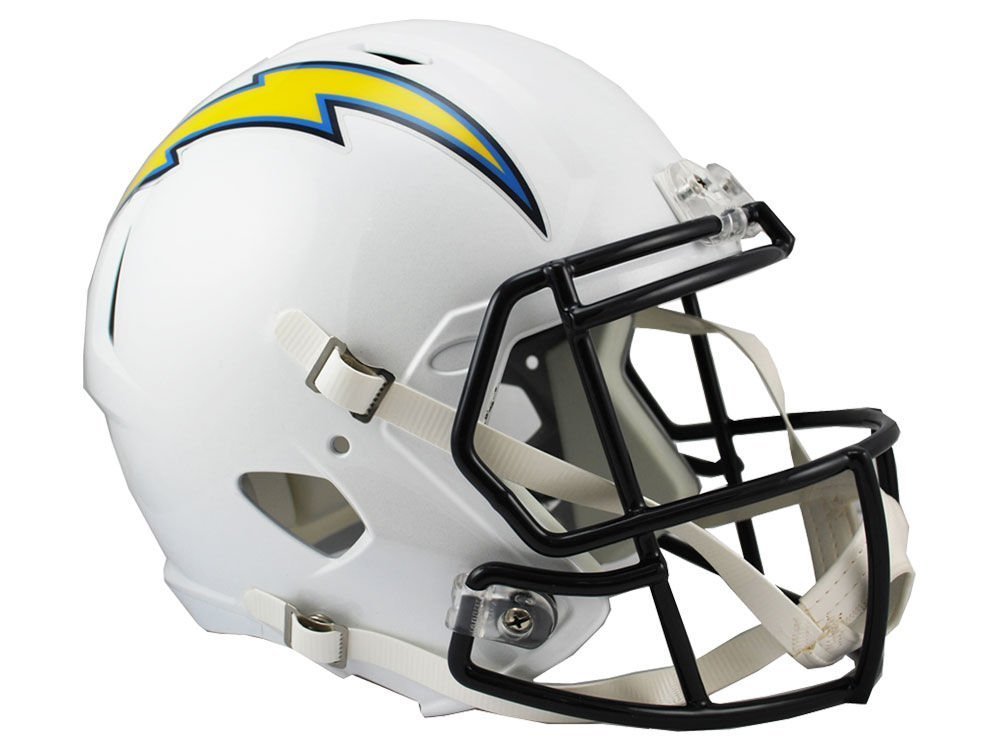
Welcome to NFL Essentials! We have teamed up with Amazon to make it easy for you to expand your NFL world! Get ready for a great 2018 NFL season.
This page was created to assist NFL fans throughout the country how to stay on top of the latest, greatest NFL products and gear! This page is simply packed with all kinds of cool NFL items from game day gear to BBQ accessories. If you like to tailgate, this page is for you. If you like host Monday Night Football parties, (or Sunday Night) this page is for you. Plus everything in between! It goes on and on. New born baby? Get him or her dressed in your favorite team’s apparel before the big game! Last minute gift shopping? We gots you covered. Welcome to NFL Essentials! Its fun here.





